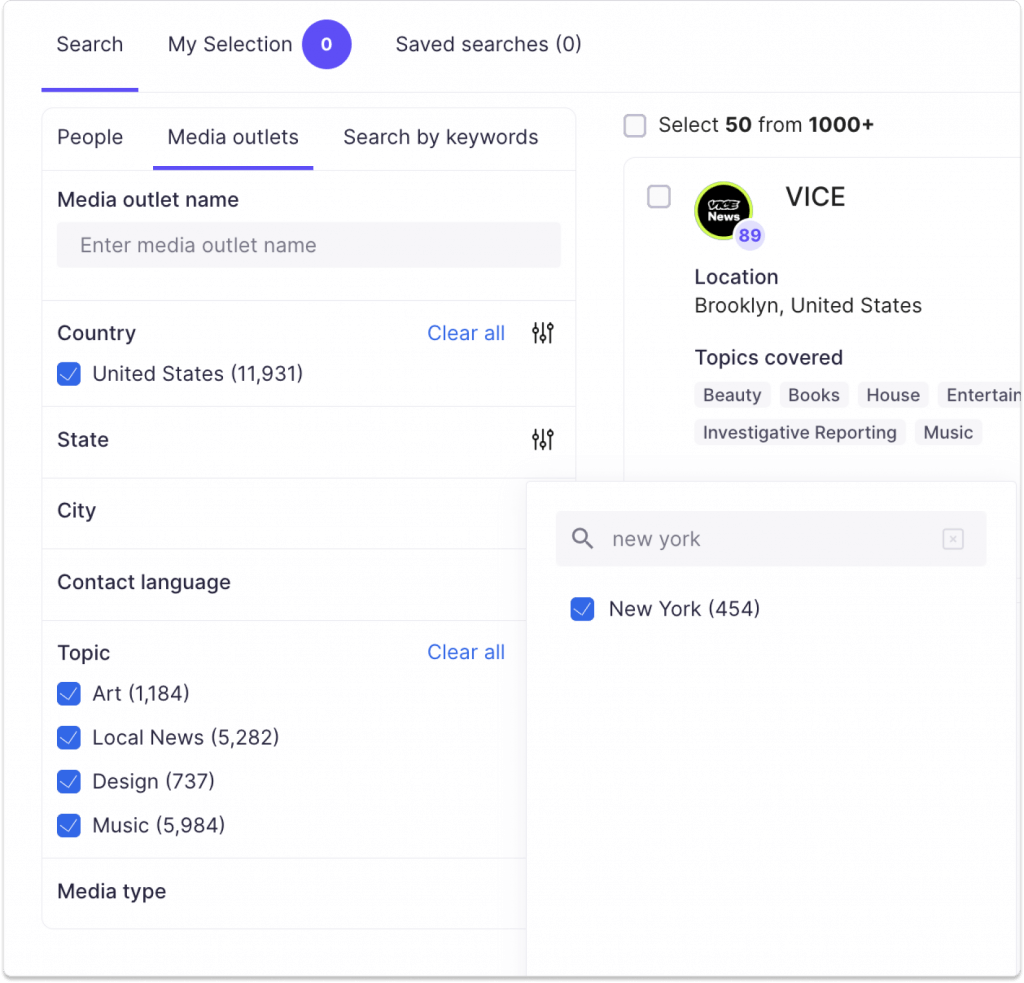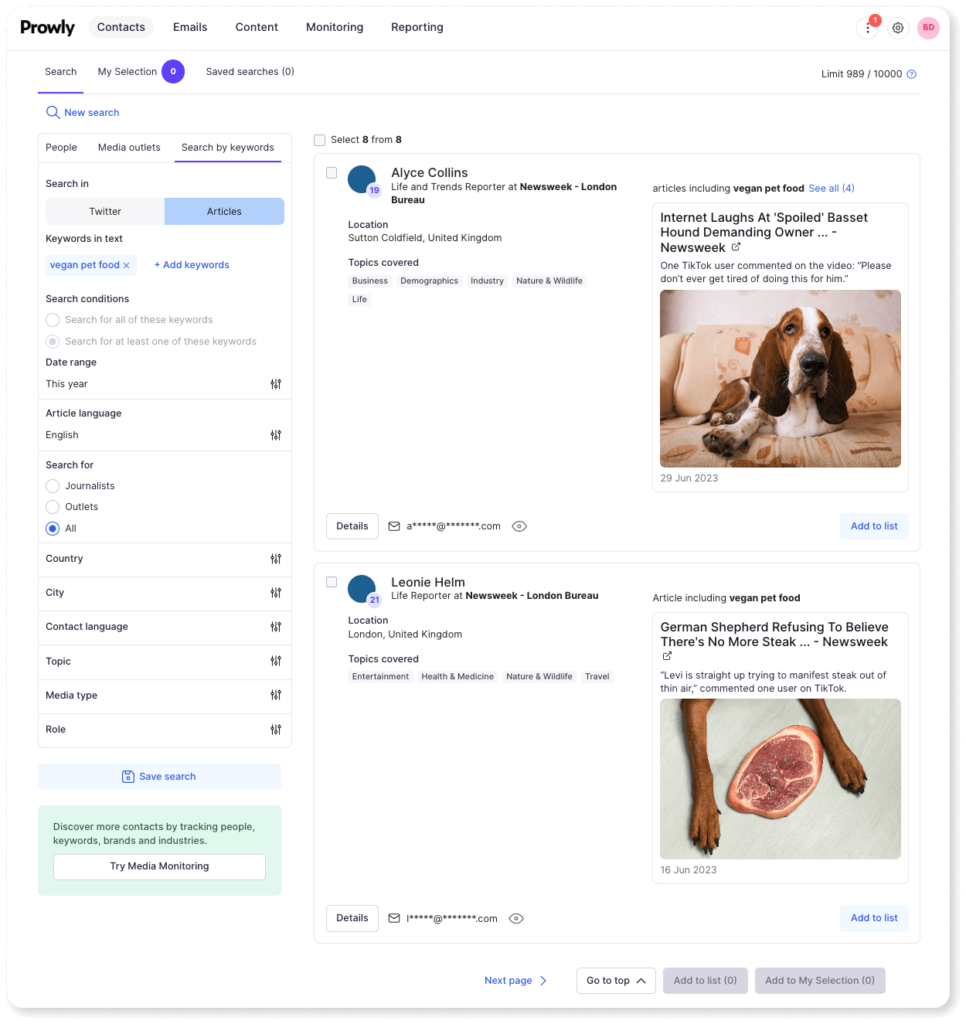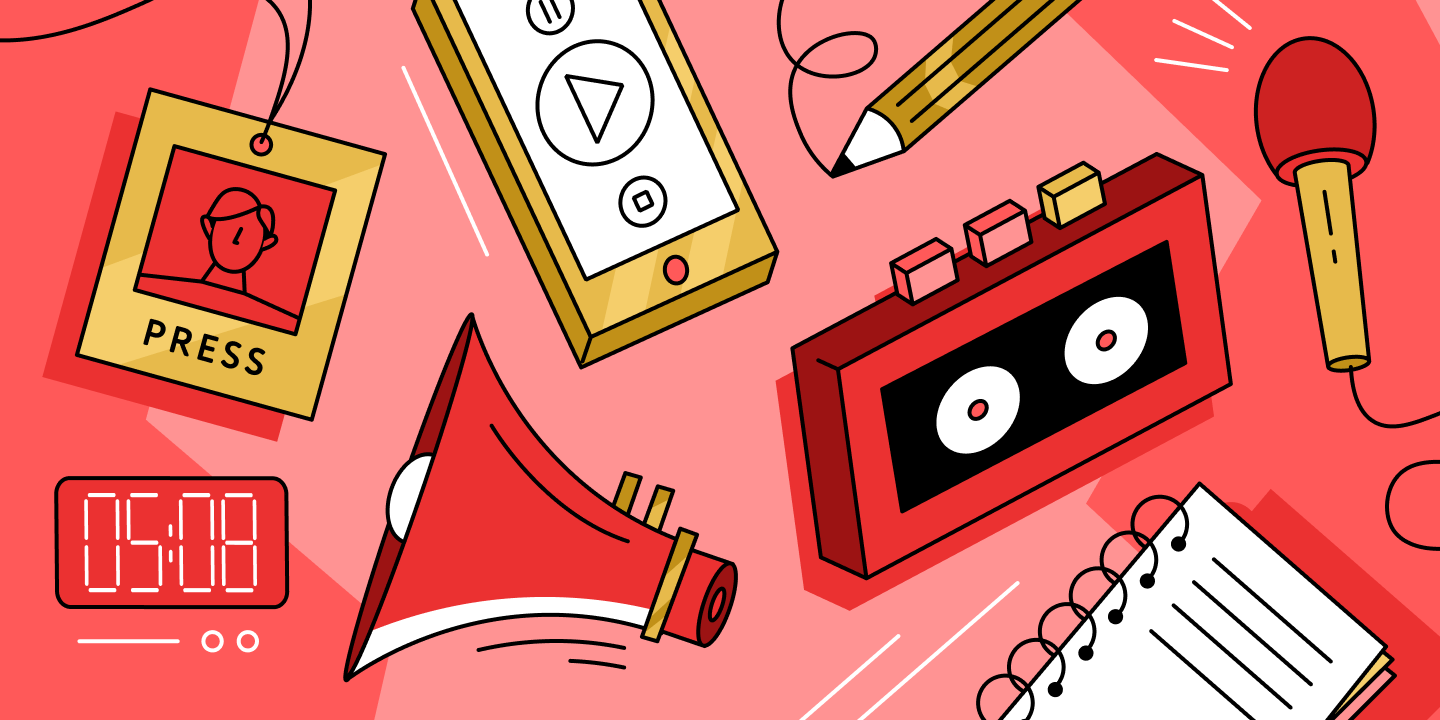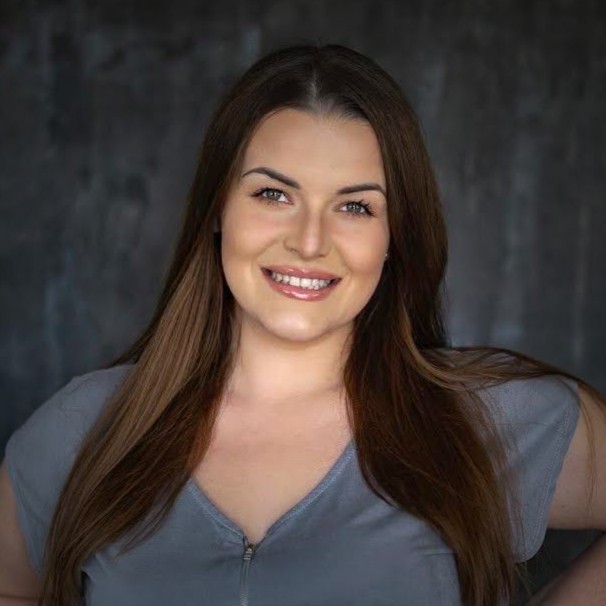Ever get nervous before doing an interview? Or maybe it's your first one, and you want to prepare yourself the best you can.
Miscommunication, missed opportunities, and results that don't yield the answers you were hoping for are all common interview mistakes - which you can omit if you know these few rules and tactics.
Discover interview essentials, including training in soft and hard skills, and preparing for flawless meetings with interviewees:
- How to conduct an interview?
- How to prepare questions for the interview process
- 15 interviewing tips for journalists and PR pros
- A go-to guide to recording in-person interviews
- Hands-on tips for recording online interviews
Go to Prowly’s Media Database and create a list of relevant contacts that might be interested in the content of your interview
How to conduct an interview? 5 key media interview tips
#1 Starting an interview is just as important as knowing how to end an interview
Assess the interviewee's mood before and after the interview. How do you think they feel? Are there any visual cues you can detect immediately?
👉 Adjust your opening, and ending questions according to their behavior.
#2 Do in-depth research beforehand
Knowing all the ins and outs about the topic will put you in a winning position in guiding the conversation.
👉 See who the person is, research their past interviews (if applicable), try to remember key points about the topic itself, and use them to your advantage during the interview.
#3 Know your goals before you start the interview
What is it that you want to know? It's easy to get sidetracked during an interview. There may be questions for journalists conducting an interview online.
👉 However, make sure you prepare your own, personalized questions that will yield the answers you're looking for.
#4 Check the space and equipment
The worst thing that can happen is a malfunctioning microphone or a space where you can hear disruptive outside noises. Imagine your interviewee not being able to focus on giving you the answers because there's construction going on right outside.
👉 Hiring someone to help you out may be a great idea.
#5 Remember it's a conversation
Rather than asking questions, and having a person answer them, make sure it's more of a dialogue between the both of you.
👉 Think of it this way: someone is telling you a story, and you're asking the right questions to make them feel heard and keep them going.
How to prepare questions for the interview process
The interview itself won't take you long, but the time you'll put into preparations can make or break the results you'll get. Here are a few tips on how to research everything you need to and ask the right questions during an interview:
💬 Ask open-ended questions
If your questions are too specific, you'll probably get robotic answers without much imagery and background. To elicit a conversation, ask open-ended questions and follow up with inquiries related to that one later.
💬 Focus on their experience
You never know if the person you're interviewing believes they're subject matter experts in what you're asking them about. Try to make them more confident, highlight their experience, and make them feel as if they're the best person for this interview.
💬 Lead, but not too much
You're in charge of the interview, however, don't steer towards a particular response. Yes, you have your own goals, but remember that forcing a respondent to say something they might later regret will result in a lack of authenticity and ethics.
Do you want to make your interview reach not only a wide audience but also the right one? You can find relevant journalists by going to Prowly’s Media Database and filtering them by country, topics, language, and more.

15 interviewing tips for journalists and PR pros
1️⃣ Conversation-first approach
The interview process is not about asking questions and having the other person answer them.
Well, it kind of is, but there are several helpful interview tips that you need to incorporate to have it flow naturally.
→ Be inviting and open to storytelling, and in turn, listen with reflection.
The more you understand the essence of what they're trying to say, the more you'll be able to empathize and make them feel like you've got a personal connection.
2️⃣ Your questions can (and should) change
You've definitely prepared a set of questions you want to ask, but:
→ make sure to guide it more like a conversation, and less like a Q&A.
While it's good to know exactly what you want to ask, consider having many options and practice beforehand so that your media interviews don't feel inauthentic.
3️⃣ Conversation flow control
When you're thinking of the most powerful interviewing techniques, consider learning how to redirect conversations where you want them to go. Make sure you do so without interrupting the interviewee.
→ To do this, gently guide the person so that they cover all the essential points naturally.
And for a curated list of contacts who might be interested in your story and topic, head over to Prowly’s Media Database. You will learn more from the guide on how to do PR outreach.
4️⃣ Timeline interrogation
While "interrogation" sounds like you're the one who's going to be interviewed by the CIA, don't worry.
It's a scary name for a method that simply calls for asking straightforward questions and constructing inquiries so that your interviewees will slowly but surely recall all of the events chronologically.
5️⃣ Use interviewee idiosyncrasies in the article
Do you know how to interview in general, or how to interview someone for an article?
→ Remember that it's not about just holding a great conversation, but noting down things that are original to their personality.
Do they have a unique perspective, use specific idioms, or use words others don't? Make sure you jot it down and later put it in your article so that it feels more authentic.
6️⃣ Meta-questioning
Some of the best tips for interviewing someone also suggest that you should start meta-questioning your interviewee.
→ These include questions about their underlying thought process or personal decision-making strategies.
Not only does that intensify the dialogue, but also opens the door for uncovering valuable insights into their thought patterns.
7️⃣ Silent note-taking
→ When you're actively taking notes during an interview, consider occasionally pausing and stop writing.
→ As you pause, one of the interview techniques is to also look them closely in the eye and maintain attentive body language.
Thanks to these intervals, you'll create a natural opportunity for the person you're interviewing to give you additional insights. Plus - interviewees will connect more with you and express themselves more comprehensively.
8️⃣ Hypothetical scenarios
Introducing hypothetical scenarios is one of the hottest tips for conducting an interview.
- It allows you to conduct an effective interview by examining the person (or brand) in all kinds of ways, from top to bottom.
- It's a wonderful way to get an insight into their strategic thinking, see where you can pull their tongue a bit more, and which topics they feel more comfortable, or uncomfortable with.
It all depends on your goal, but hypothetical scenarios can provide tons of valuable insights.
9️⃣ Body language calibration
Public relations interview questions are not only about speaking. It's also about monitoring your interviewees' body language and adjusting your own to mirror theirs. Non-verbal communication is as important as the verbal one.
→ Oftentimes consciously choosing the gestures, facial expressions, and posture can help create a more comfortable and open atmosphere.
🔟 Try non-traditional settings
Previously, when people thought of the interview process, the image in their head resembled a corporate setting, especially if it was a media interview with a public person. Of course, interviews at people's homes or other places happened too, but it had to be connected somehow with the story itself.
Now, interviews are conducted nearly everywhere.
Have you seen celebrities and influencers doing podcast interviews dressed in sweatpants? It has yet to be this casual for, let's say, political guests, but slowly moving away from a formal setting is beginning to be the norm.
No wonder, since it leads to more candid and spontaneous interactions.
1️⃣1️⃣ Stakeholder role play
→ Ask interviewees to pause and step into the shoes of different clients, team members, and stakeholders who are involved in the topic you're speaking about.
Such a practical approach can provide in-depth insights into how they think about their environment holistically.
Pro Tip: If you're wondering how to conduct a good interview using stakeholder role play, come up with a controversial scenario or one your audience will be interested in. However, make sure to analyze who your interviewee is beforehand since some questions might be off-limits.
1️⃣2️⃣ Memory association techniques
→ Ask about specific memories related to the topic.
Whether it's pairing information with vivid images, rephrasing the material into your own words so that you can express what they said from a different point of view, or even talking about the colors, sounds, and textures that might have been there can facilitate a more genuine and authentic conversation.
1️⃣3️⃣ Empathy mapping
→ During an interview, construct an empathy map.
It can give you an assessment of what the interviewee thinks about the topic and how are they connected to it emotionally. Make sure to note emotional cues, concerns, and aspirations.
Don't forget about body language! By using empathy mapping as one of the interview techniques, you'll see where to guide the interview towards a more meaningful and insightful discussion.
1️⃣4️⃣ Pattern interrupt
→ Introduce unexpected questions and twists, or slightly change the interview dynamic to break the pattern.
It's more of a psychological tool used to guide the other person's behavior, but also a wonderful method for gauging your audience's attention with questions and answers they might have not expected.
→ When conducting an interview, start speaking first.
Then, you can guide the conversation and mix in other pattern interrupt techniques, such as oversharing, objecting to the other person, or being verbally ambiguous.
1️⃣5️⃣ Narrative visualization
→ Ask your interviewees to try and visualize their responses.
That way, they will be able to tell you more details about it, and essentially "paint a picture" of the story they're talking about. This is exactly what makes a good interview – descriptive imagery and an engaging storyline.
To find journalists and their contact information, simply head over to Prowly’s Media Database and send them a brief summary of your interview with key highlights.

A go-to guide to recording in-person interviews
Read on to find out how to conduct an interview. Journalism is one of those industries where you have to put on many hats, and well, knowing how to do a good interview with up-to-date technology is one of them.
Equipment and preparation
▪️Do you have a high-quality microphone on hand? Make sure you've tested it before and it's a directional microphone that captures clear audio from the interviewee.
▪️Tried and tested camera setup: while there are plenty of high-quality cameras around, the key is proper lightning and having the correct setup (Pinterest is great for visuals on how you should organize the setting)
▪️Enough storage: can you imagine having an interview and half of it doesn't save because you've run out of memory? That's a preventable mishap though, so make sure to check the size of your memory card twice.
Recording tips
▪️Check out the environment: make sure the place you've picked is not overly noisy or has really bad lighting even with artificial lamps.
▪️Obtain necessary consent forms: depending on the laws of the state or country you're in, you may need to get a written consent form in addition to a verbal one.
▪️Make it natural: if there are mishaps during the interview, try not to ask the interviewee for too many retakes. Instead, ask if you can edit certain moments and disregard those that were not up to par.
Hands-on tips for recording online interviews
Software and recording tools
▪️ Test your software beforehand
If you're flexible, you can ask your interviewee what platform they prefer or suggest a platform or two yourself so they can pick it out. If you want to use, for example, Zoom specifically, make sure they know how to access it.
▪️ Use backup recording software just in case
You can even use the audio recording feature on your phone, just to make sure nothing is missed if the original version doesn't work out.
Preparation and settings
- Do you have a high-speed, stable internet connection?
You can even be one step ahead and check in with your provider if they're doing any maintenance breaks. Unlikely, but being overprepared is better than being underprepared. - Are you going to record during the day, or at night?
Depending on where you are, you might need to adjust the lighting and camera. While natural light is beautiful, it might play tricks on us so make sure to figure out that situation beforehand.
General online recording tips
▪️ Record the video locally and save it to your device for better video and audio quality
Later, you can edit it in any way you'd like if necessary.
▪️ Look at the person as you would in an in-person interview
It's not easy to do at first, but with a little bit of practice, you'll be conducting interviews with ease.
▪️ Don't even think about leaving your camera off
If you're feeling under the weather, simply reschedule. It's already difficult to establish a connection with the other person online, and shutting your camera off can make the experience even more cold.
Get ready to plan your interview
Conducting a successful interview is not just having a bunch of journalist interview tips written down on a piece of paper. It's more about preparing yourself beforehand, anticipating where the conversation might lead, and using techniques that yield to getting the answers you need.
To send an interview to the media, you can go to Prowly's Media Database and look up relevant journalists who might be interested in your story.
For better results, make sure to emphasize the highlights of your interview in the first few lines of the email.

